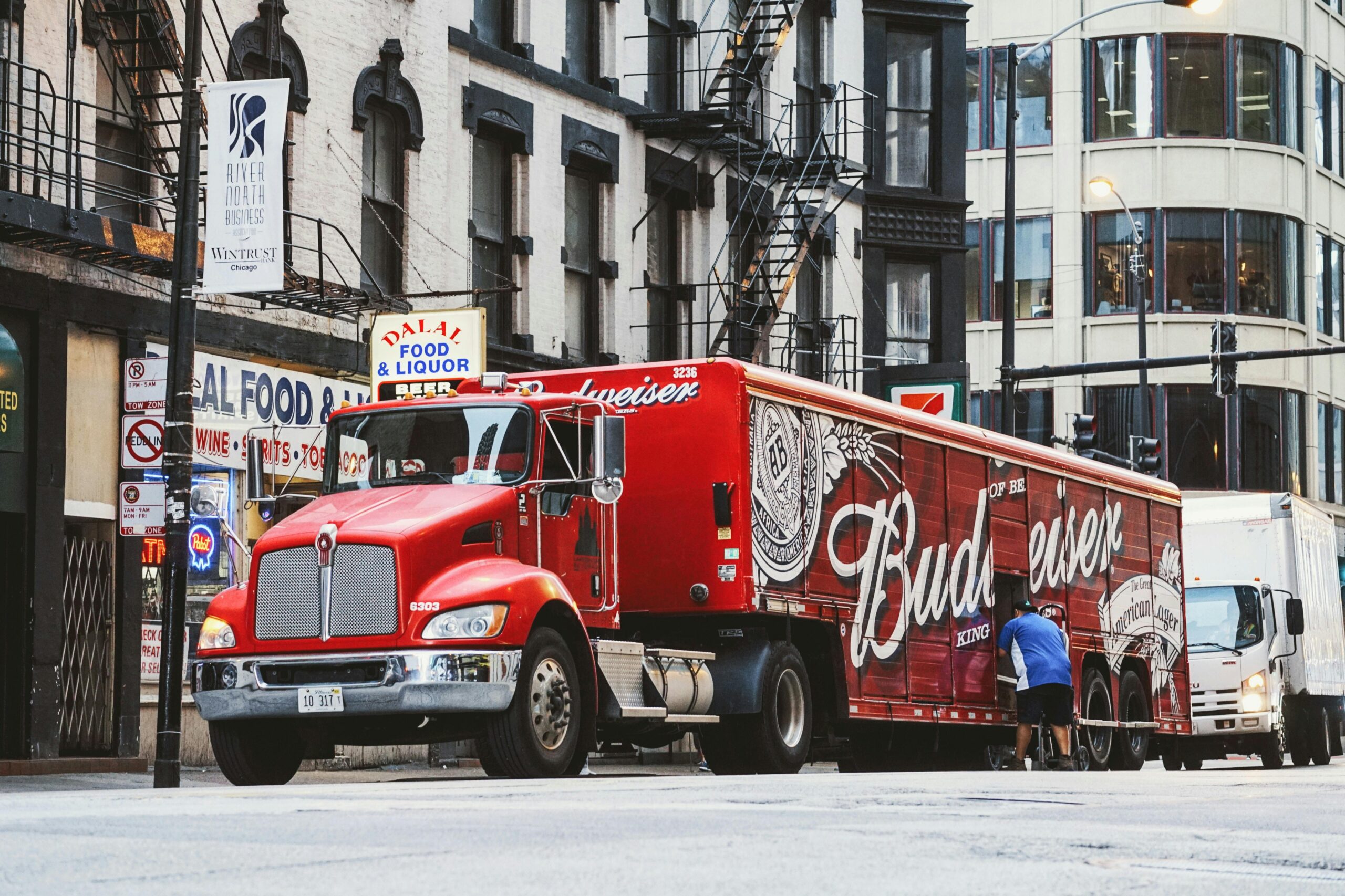8 Facts about Food Industry Truck Drivers
Last Updated on July 12, 2025
Your favourite products travel from all over the world just to get to your door step.
Many of them were produced in factories miles away and transported to distribution centres or directly to stores. For smaller shipments, businesses often use couriers; however, when it comes to delivering large volumes of goods, especially from manufacturing plants, the process becomes significantly more complex.
Food Industry Truck drivers play a vital role in this journey, ensuring items like your favourite cookies get from factories to your home.
In this article, we’ll explore how truck drivers expertly handle the challenges of transporting goods from factories to ensure products make it to stores and, eventually, to your home.
1. Food Industry Truck Drivers transport processed food products
Truck drivers in the food industry are responsible for:
loading, transporting, and delivering food orders to customers. They work for a variety of employers, including food manufacturers, distributors, and logistics companies. The type of employer often influences the types of loads they carry and the vehicles they drive. For example, long-haul drivers transport goods across provinces or countries, spending days on the road, while local delivery drivers focus on shorter routes to ensure that fresh food reaches nearby stores, restaurants, or distribution centres.
These drivers are the backbone of food delivery, ensuring it reaches its destination safely and timely. They follow strict food safety guidelines to protect the integrity of the products they transport. This might include washing their trucks between delivery loads. This practice is particularly important in the food industry, as the items they deliver are ultimately meant for consumption. Keeping trucks clean inside (and out!) helps protect the health of those who receive the food.
Truck drivers in the food industry face unique challenges, including managing tight schedules and transporting perishable goods. Even a small delay can lead to spoiled products and significant financial losses.
Often, truck drivers represent their companies when delivering items, making their role crucial. Being friendly and addressing customer concerns on the spot is an importpart of their job. Additionally, the physical demands of long hours on the road and lifting heavy loads make staying in shape essential.
Overall, effective truck drivers need to plan smart routes, communicate clearly and always stay on top of whatever the job throws at them.
2. Food Industry Truck Drivers adhere to food safety standards
Maintaining food safety is essential at every stage of the supply chain, from the farm to processing and ultimately to consumers. Drivers play a crucial role in this process by adhering to strict hygiene practices. This includes regularly cleaning their vehicles, wearing protective gear, and following food safety standards. For instance, they need to monitor the temperature of their cargo closely. If the temperature rises into the “danger zone” and then cools down again, it could pose a risk of foodborne illness for consumers.
In Canada, food transportation is governed by the Safe Food for Canadians Regulations (SFCR), which outline the necessary rules to keep food safe during transit. Failing to comply with these regulations can result in serious consequences, such as fines, harm to a company’s reputation but most importantly can cause serious sickness to the consumer. To ensure compliance, drivers must document their procedures, demonstrating that they have adhered to safety standards. These practices are vital for keeping food safe and of high quality from production to delivery.
3. Food Industry Truck Drivers require a driver’s license
To become a truck driver in the food industry, the requirements can vary based on the size and type of commercial vehicle being operated. Generally, a high school diploma or GED is necessary to ensure foundational skills, and a valid driver’s license in good standing is required for operating smaller vehicles, such as light-duty delivery trucks.
For drivers of larger vehicles, such as the heavy-duty trucks commonly seen on highways, obtaining a Commercial Driver’s License (CDL) is mandatory. To acquire a CDL, individuals must pass both a written knowledge test and a skills test, which evaluates their ability to operate the vehicle safely and responsibly.
Many companies in the food industry provide training programs designed to meet their specific needs. These programs teach new drivers how to operate specialized equipment, such as refrigerated trucks (reefers), and offer guidance on maintaining proper food storage temperatures during transit to ensure the safety and quality of products. The Training may also include an overview of critical food safety regulations, such as those set by the Food Safety Modernization Act (FSMA), as well as best practices for transporting perishable goods.
4. Food Industry Truck Drivers need to manage their time
Unlike clothing or electronics, food products have limited shelf lives and must reach customers quickly. Any delay in delivery can lead to spoilage, resulting in financial losses and potential food safety hazards.
For example, delivering dairy products or frozen foods often requires navigating early or late-night routes to avoid delays and maintain quality. Unpredictable demand, especially during peak seasons, adds complexity, necessitating that drivers remain flexible and adaptable.
5. Food Industry Truck Drivers need to have customer services skills
These professionals act as the face of a food company to customers such as store managers, restaurant staff and other clients. If they are truck drivers with regular routes around the city, they are likely to interact with the same people on a regular basis. Therefore it is essential for them to be professional and communicate clearly. It is encouraged for drivers to build relationships and troubleshoot problems on the fly. Not only is this valuable for securing repeat business, but it also makes the job much more fun!
6. Food Industry Truck Drivers must be physically fit
Truck drivers in the food industry spend many hours on the road and face physically demanding tasks at delivery sites. They may be required to lift boxes weighing 40 to 50 pounds or more, such as those not part of a pallet that can be moved with a forklift or pump lift.
Additionally, the job requires sitting for extended periods while driving, which can strain the back and legs over time. To alleviate this, truck drivers will take breaks every few hours to walk around. Many large companies now require drivers to pass fitness tests to ensure they are physically capable of handling the job demands, including lifting and enduring long hours behind the wheel.
7. Food Industry Truck Drivers are continuously using technology in their work
Gone are the days when it was just a truck driver with a paper list and their cargo. Today, technology is becoming increasingly used in a truck driver’s job.
- Electronic Logging Devices: These devices automatically record a driver’s hours of service (HOS) to ensure compliance with regulations. So truckers don’t overwork themselves!
- Collision Mitigation Systems: These systems use sensors and cameras to detect potential collisions and take corrective actions such as warning the drivers or applying the brakes.
- Cargo Tracking and Management Systems: Some advanced trucks even have sensors that provide data on trailer temperature, humidity and load stability.
For example, a driver transporting fresh dairy might use temperature-monitoring apps linked to sensors within the refrigerated truck. These monitoring apps allow them to respond to any deviations instantly, ensuring the product’s safety.
8. Food Industry Truck Drivers plan their work, communicate and are perceptive
Being a food industry Truck Drivers demands a diverse range of skills, but some are absolutely essential. These skills are not just beneficial, they’re crucial for success in this role:
- Communication: While a driver’s job often involves spending much time alone on the road, communication remains essential. For instance, drivers must inform their managers, customers, or planners about delays or issues. If they don’t communicate, it can lead to late deliveries and problems with scheduled tasks.
- Route planning: Although companies will assist truck drivers in planning their routes, unexpected delays and other issues such as poor weather or traffic may arise. Drivers need to know how to update their routes if something arises continuously.
- Preceptiveness: Preceptiveness is the ability to notice and understand things others might not. Drivers must stay alert and aware of their surroundings at all times. This includes reading road conditions, watching for hazards, and understanding how their vehicle affects others on the road. Strong awareness helps prevent accidents and ensures everyone’s safety.





Comments are closed